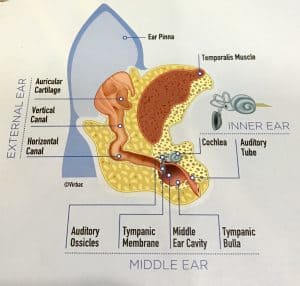Ear Infections

Many dogs will have an ear infection at some point in their life. The unlucky ones will get them every couple of months.
There are a couple of reasons why this is the case.
- Shape of the ear canal – dogs have a “J-shaped” ear canal i.e. vertical and horizontal components. This means it’s much harder for the body to get debris, infections and even grass seeds out of the ear as they must go upwards instead of straight out. Accumulation of ear wax, skin oil, and other debris feed the bacteria and fungi that live in the normal ear canal leading them to proliferate, leading to an infection.
- Narrowing of the ear canal – this may be related to the breed e.g. Shar Peis or due to recurring ear infections over time. A narrow canal traps debris, wax and water, leading to infection.
- Allergic skin disease – dogs who are prone to skin allergies tend to accumulate wax which leads to infection. The moisture of the wax provides a fuel source for bacteria and yeast to proliferate.
- Excessive hair in the ears – this is common in poodles, schnauzers and their crosses e.g. Groodles, Labradoodles. The hair traps moisture and wax leading to infection.
- Foreign bodies e.g. grass seeds – Foreign bodies bring contamination into the ear and often get stuck, trapping the source of infection into the ear.
Signs to watch out for include:
- Head shaking
- Scratching at the ears
- Redness of the ear/s
- Pain when touched near the base of the ear
- Odour coming from the ears/head
There are a range of different bacteria and fungi that can infect the ear.
It is important that you bring your pet into the vet when you suspect an ear infection. The vet can examine the ear with a special scope and take swabs. Swabs are looked at in-house under the microscope, allowing prompt treatment with the correct ear medication specific for that particular infection.
Topical antibiotics are the most effective treatment and will often be combined with an oral steroid to help reduce the pain and inflammation.
Every infection is different and may change over time so it is essential to recheck your pet’s ear when recommended, as the medication may need to be extended or changed. DO NOT stop the course too soon as this will lead to continued infection and antibiotic resistance. Occasionally the infections can be very challenging to treat and require ear flushing under sedation and further testing at the lab.
For those dogs that have recurring ear infections owners need to do home maintenance.
This means using a prescribed cleaning solution every 1-2 weeks. Cortavance steroid spray can also be used 1-2 times a week to reduce inflammation and irritation.
